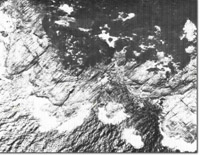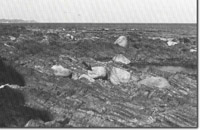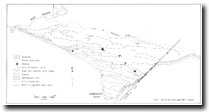8822-16 Sandpatch Point
|
This information has been developed from the publications:
|
Location: | 285215. Seven kilometres north-east of Wingan Inlet. |  Shore platform in jointed granite - Sandpatch Point. |
Abstract: | Headline of Granite and sedimentary rock capped by vegetated and mobile dunes. | |
Access: | 4 wheel drive tracks lead to Bennedore River and to the rear of Sandpatch Point. Approximately three hour walk around the coast from Wingan Inlet. | |
Ownership: | Crown Land (Croajingolong National Park) | |
Geology: | The headland is of grey biotite granite which is continuously exposed around the shoreline. The granite is coarse grained and strongly jointed with the joint sets intersecting at almost 90º. Several basaltic dykes intrude the granite. Along the north-east of Sandpatch Point is a contact zone between the granite and the sedimentary rocks of the Mallacoota Beds. This contact is well displayed along several hundred metres of shoreline and is in part a faulted contact. The sedimentary rocks display bedding and deformation structures and have been intruded by aplite and pegmatite dykes and sills. The headland is capped by active dune sands and vegetated parabolic dune ridges. | |
Geomorphology: | The granite rocks from a steep coast on all sides. There is minimal shore platform developments and the regular jointing pattern determines the orientation of clefts and gutters. The nature of the coast changes with the geology, and gravel beaches and irregular shore platforms have developed on the north-eastern side of the Ordovician sedimentary rocks. Large blocks of granite rest on parts of this shore platform and are an indicator of the strength of wave activity. An arch or sea cave has been eroded along the strike of the Ordovician rocks. An unusual and temporary feature is the formation of beaches of broken abalone shell as a result of commercial harvesting and shelling of these off the eastern shore. The dune that caps Sandpatch Point have been generated from sandy beaches to the west of the headland and in places have blown across the point and spilled into the sea on the eastern shore. Most of these formerly active dunes are now vegetated by coastal scrub and examination of early maps and photographs indicates extensive revegetation of the dunes has taken place over the last 100 years. | |
Significance: | State. The site displays a clear contact zone between granite and sedimentary rocks and is of considerable geological interest for both structural and petrological study. Of major geomorphological interest is the difference in shoreline morphology on the different rock types. Preliminary studies indicate that the dunes are undergoing a phase of rapid re-vegetation and stabilisation and this is a particularly important site for monitoring of this process. | |
Management: | Continued studies of the process of dune vegetation are dependent on minimal disturbances to the dune area. Access tracks. (vehicular and pedestrian) should be located well away from the dune areas on the western side and as the main area of geological interest is on the eastern side, any visitor access should be directed to this area. | |
References: | Rosengren, N. J. 1978. The Physiography of Coastal Dunes, East Gippsland, Victoria. M. A. Thesis (Unpub.), University of Melbourne | |
 Boulders of granite (arrowed), transported by wave action and resting on Ordovician sediments - Sandpatch Point. |




